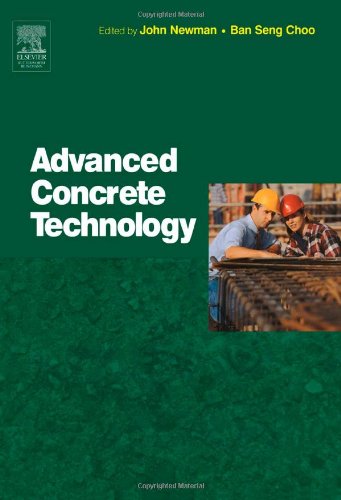

Most ebook files are in PDF format, so you can easily read them using various software such as Foxit Reader or directly on the Google Chrome browser.
Some ebook files are released by publishers in other formats such as .awz, .mobi, .epub, .fb2, etc. You may need to install specific software to read these formats on mobile/PC, such as Calibre.
Please read the tutorial at this link. https://ebooknice.com/page/post?id=faq
We offer FREE conversion to the popular formats you request; however, this may take some time. Therefore, right after payment, please email us, and we will try to provide the service as quickly as possible.
For some exceptional file formats or broken links (if any), please refrain from opening any disputes. Instead, email us first, and we will try to assist within a maximum of 6 hours.
EbookNice Team

Status:
Available0.0
0 reviews
ISBN 10: 0750651032
ISBN 13: 9780080489988
Author: John Newman, Ban Seng Choo
Part 1: Cements
Chapter 1. Cements
1.1 Introduction
1.2 History of Portland cement manufacture
1.3 Chemistry of clinker manufacture
1.4 Cement grinding
1.5 Portland cement hydration
1.6 Portland cement types
1.7 Cement production quality control
1.8 Influence of cement quality control parameters on properties
1.9 Relationship between laboratory mortar results and field concrete
1.10 Applications for different cement types
1.11 Health and safety aspects of cement use
References
Chapter 2. Calcium aluminate cements
2.1 Introduction
2.2 Chemistry and mineralogy of CACs
2.3 Properties of fresh CAC concrete – setting, workability, heat evolution
2.4 Strength development
2.5 Other engineering properties
2.6 Supplementary cementing materials
2.7 Durability/resistance to degradation
2.8 Structural collapses associated with CAC concrete
2.9 Modern uses of CAC concrete
2.10 Use of CACs in mixed binder systems
2.11 Summary
References
Part 2: Cementitious Additions
Chapter 3. Cementitious additions
3.1 The pozzolanic reaction and concrete
3.2 Fly ash as a cementitious addition to concrete
3.3 Fly ash in special concretes
3.4 Natural pozzolanas
3.5 The use of ggbs in concrete
3.6 Silica fume for concrete
3.7 Metakaolin
3.8 Limestone
References
Part 3: Admixtures
Chapter 4. Admixtures for concrete, mortar and grout
4.1 Introduction
4.2 Dispersing admixtures
4.3 Retarding and retarding plasticizers/superplasticizing admixtures
4.4 Accelerating admixtures
4.5 Air-entraining admixtures
4.6 Water resisting (waterproofing)
4.7 Corrosion-inhibiting admixtures
4.8 Shrinkage-reducing admixtures
4.9 Anti-washout/underwater admixtures
4.10 Pumping aids
4.11 Sprayed concrete admixtures
4.12 Foamed concrete and CLSM
4.13 Other concrete admixtures
4.14 Mortar admixtures
4.15 Grout admixtures
4.16 Admixture supply
4.17 Health and safety
Further reading
Part 4: Aggregates
Chapter 5. Geology, aggregates and classification
5.1 Introduction
5.2 Fundamentals
5.3 Geological classification of rocks
5.4 Sources and types of aggregates
5.5 Classification of aggregates
5.6 Aggregate quarry assessment
5.7 Deleterious materials in aggregates
References
Chapter 6. Aggregate prospecting and processing
6.1 Aims and objectives
6.2 Introduction
6.3 Extraction and processing of sand and gravel
6.4 Processing
6.5 Extraction and processing of limestone
6.6 Summary
Further reading
Chapter 7. Lightweight aggregate manufacture
7.1 Introduction, definitions and limitations
7.2 Lightweight aggregates suitable for use in structural concrete
7.3 Brief history of lightweight aggregate production
7.4 Manufacturing considerations for structural grades of lightweight aggregate
7.5 Production methods used for various lightweight aggregates
7.6 The future
7.7 Conclusions
References
Chapter 8. The effects of natural aggregates on the properties of concrete
8.1 Aims and objectives
8.2 Brief history
8.3 Introduction
8.4 Classification
8.5 Sampling
8.6 Grading
8.7 Maximum size of aggregate
8.8 Aggregate shape and surface texture
8.9 Aggregate strength
8.10 Aggregate density
8.11 Drying shrinkage
8.12 Soundness
8.13 Thermal properties
8.14 Fines content
8.15 Impurities
8.16 Summary
journal of advanced concrete technology
journal of advanced concrete technology scimago
msc advanced concrete technology
journal of advanced concrete technology abbreviation
advanced concrete technology inc
Tags: John Newman, Ban Seng Choo, Concrete Technology